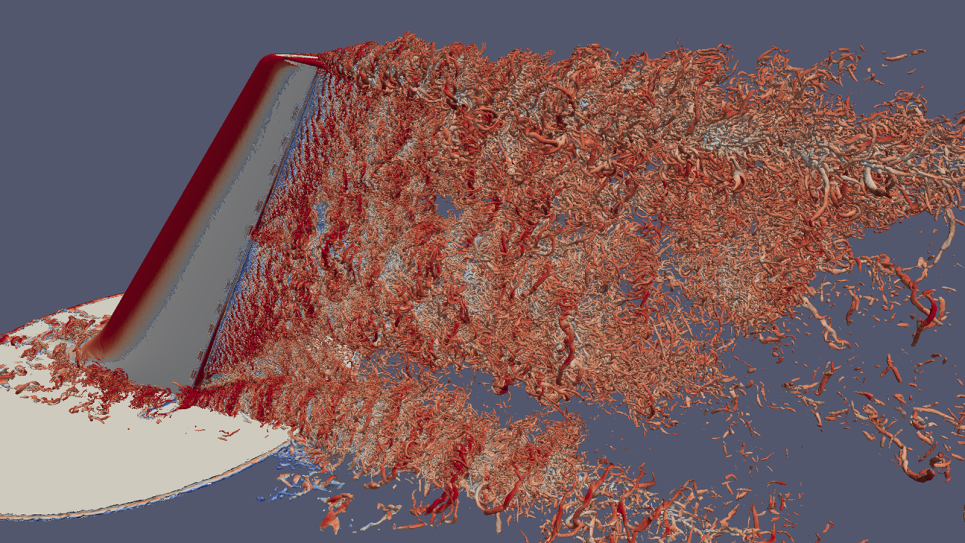
Turbocharging engine design
For scientists and engineers, the process of improving the performance of engines and fuels feels a bit like driving on a one-lane highway. They must often develop and test their designs and prototypes one at a time, which slows the pace of innovation.
Computers can accelerate the process by simulating how fuels and engine designs affect performance and emissions. Yet most computers can handle only a handful of scenarios at once — too few to create a full picture of fuel performance during combustion.
Now researchers at the Department of Energy’s (DOE) Argonne National Laboratory have moved the development process into the passing lane. For the first time, Argonne’s scientists and engineers pinpointed engine designs for a given fuel using the Mira supercomputer at the heart of the Argonne Leadership Computing Facility (ALCF), a DOE Office of Science User Facility.
With Mira’s supercomputing prowess, Argonne’s Virtual Engine Research Institute and Fuels Initiative (VERIFI) team simulated over 2,000 engine design combinations and “reduced design time from months to weeks,” said Sibendu Som, group leader and principal computational scientist at Argonne.
Argonne’s simulations were conducted with design scenarios from the Aramco Research Center — Detroit, one of three U.S.-based research centers operated by Saudi Aramco’s North American subsidiary, Aramco Services Company (ASC). One area of their research seeks to match engine combustion modes with improved fuel properties to create higher efficiency and lower emission transportation technologies.
“The simulations performed by Argonne found two optimized fuel-engine concepts that could improve fuel efficiency substantially,” said Yuanjiang Pei, a lab scientist who specializes in computational fluid dynamics at the Aramco Research Center — Detroit.
Aramco’s Detroit program includes a range of whole-system automotive research, which includes advancing spark ignition, compression ignition and gasoline compression ignition (GCI) engine technologies. Aramco is examining current market fuels as well as exploring the development of new fuel formulations.
“We are analyzing how well new fuel formulations combust compared to conventional fuels and if they can be optimized to work better,” said Som.
By simulating how a highly volatile, low-soot fuel behaves in many engine designs, “We hope to retain the performance of diesel fuel with lower particulate matter and nitrogen oxide emissions,” said Roberto Torelli, an Argonne postdoctoral researcher on Som’s team.
Som and colleagues simulated fuel-engine performance under four operating conditions and for six piston concepts, as well as various fuel injector designs and fuel injection strategies. They narrowed down the best-performing scenarios to two specific sets of piston and injector designs that are being evaluated by Aramco in its Detroit facility.
The research, explained in the paper “CFD-Guided Heavy Duty Mixing-Controlled Combustion System Optimization with a Gasoline-Like Fuel,” is one of three publications stemming from Argonne’s work with coauthors from Aramco’s Detroit research center published by the Society of Automotive Engineers (SAE).
Argonne’s other two related studies with Aramco further explore how new fuel formulations behave under various operating conditions. Som’s paper “Comparison of In-Nozzle Flow Characteristics of Naphtha and N-Dodecane Fuels” co-authored with Torelli, indicates, for example, that some fuels under investigation may cavitate or vaporize within the fuel injector before entering the combustion chamber.
A third study of simulations by Som and Argonne postdoctoral researcher Pinaki Pal, identifies the conditions at which new fuel formulations can thrive under low temperature combustion, leading to reduced emissions and higher efficiency. This third study “is the first time we have simulated higher cetane gasoline behavior at desirable low temperature combustion conditions with optimal engine designs in mind,” said Pal.
These results, vital for in-depth fuel and engine design work, are detailed in the paper “Numerical Investigation of a Gasoline-Like Fuel in a Heavy-Duty Compression Ignition Engine Using Global Sensitivity Analysis” to be published in an upcoming print edition of the SAE International Journal of Fuels and Lubricants.
The three papers were presented at the 2017 SAE International World Congress in Detroit.
Argonne National Laboratory seeks solutions to pressing national problems in science and technology. The nation's first national laboratory, Argonne conducts leading-edge basic and applied scientific research in virtually every scientific discipline. Argonne researchers work closely with researchers from hundreds of companies, universities, and federal, state and municipal agencies to help them solve their specific problems, advance America's scientific leadership and prepare the nation for a better future. With employees from more than 60 nations, Argonne is managed by UChicago Argonne, LLC for the U.S. Department of Energy's Office of Science.
The U.S. Department of Energy's Office of Science is the single largest supporter of basic research in the physical sciences in the United States and is working to address some of the most pressing challenges of our time. For more information, visit the Office of Science website.


